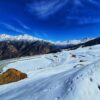Madagascar doesn’t feel like anywhere else on Earth.
It’s as if the island broke away from the continent, carried a handful of ancient secrets, and decided to keep them safe for millions of years.
The trees twist like sculptures, the lemurs sing in the canopy, and the air smells of rain, salt, and something unnameable.
It’s not polished. It’s not packaged. But it is alive in the way nature once was before we learned how to tame it.
From red deserts to emerald rainforests, from whale-filled seas to villages where time still moves by the sun, Madagascar invites you to see the world with fresh eyes.
A Living Museum — Wildlife That Exists Nowhere Else
Step into the forests of Andasibe-Mantadia National Park, and you’ll hear a haunting, almost human call echoing through the mist. It’s the indri the largest of Madagascar’s lemurs, a creature found nowhere else on Earth.
The country is home to more than 100 lemur species, each stranger and more charming than the last — some leap through bamboo, some sing at sunrise, some stare at you with golden eyes before vanishing into the green.
And it’s not just lemurs.
You’ll see chameleons smaller than your thumb, baobab trees that look like they’ve been planted upside down, and orchids that bloom only on this island. Every creature and plant feels like an artist’s experiment that somehow survived.
The Avenue of the Baobabs – Trees That Touch the Sky
Near Morondava, a dirt road lined with ancient baobab trees glows gold in the evening light.
They rise like giants — thick, timeless, patient.
Some are over 800 years old, older than any empire or map that ever mentioned Madagascar.
At sunset, their shadows stretch across the earth like paintbrush strokes. Travelers stand quietly, cameras forgotten, just watching the light change.
It’s one of those moments that feels almost holy — where nature stops being scenery and becomes an emotion.
Rainforests, Rivers, and Red Earth
Head east, and the world turns green.
The rainforests of Ranomafana shimmer with humidity, full of hidden waterfalls and creatures you’ve never seen in books. Walk slowly; everything moves frogs, snakes, orchids, life itself.
In the south, the soil burns red, cracked and raw. This is the spiny desert, where cactus-like plants twist toward the sun and zebu cattle walk through dust clouds.
Madagascar feels like a dozen countries in one world map compressed into an island.
Take a slow boat down the Tsiribihina River, passing villages where children wave from the banks and fishermen steer by stars.
Nights here are quiet just the sound of firewood crackling and crickets performing their soft concert.
Nosy Be & The Islands of the North – The Soft Side of Wild
When you’re ready for calm, sail north to Nosy Be, Madagascar’s island of perfumes.
The beaches here aren’t about luxury, they’re about life. Fishermen pull nets by hand, kids play football at dusk, and the air smells of vanilla and ylang-ylang.
Offshore, coral gardens glow beneath the surface; diving here feels like swimming through a kaleidoscope.
If you’re lucky, you’ll spot sea turtles or the gentle giants of the channel whale sharks, curious and calm.
For more solitude, hop across to Nosy Komba or Nosy Iranja, where lagoons change color with the light and time forgets to move.
Malagasy Culture – Warmth Woven Into Simplicity
The people of Madagascar, the Malagasy, are as diverse as the island’s landscapes — descendants of African, Arab, and Austronesian voyagers.
They speak softly, smile easily, and live with a quiet dignity.
Walk through a village and you’ll smell rice cooking over a woodfire, hear laughter floating from open windows, and be invited always to share a meal.
Music is constant here, often played on home-made instruments, carrying the rhythm of both the ocean and the earth.
You’ll learn the word “Mora Mora” slowly, slowly.
It’s not advice; it’s a way of living. And once you learn it, you’ll never want to unlearn it.
Food That Feels Like Home
Malagasy food tells the story of its people, simple, fresh, touched by many worlds.
Meals often start with rice, always rice served with coconut curry, grilled fish, or romazava, a fragrant stew of greens and beef.
Vanilla and cloves find their way into desserts and drinks, and fruit tastes sweeter here, as if the soil remembers every sunrise.
Street stalls sell mofo gasy soft rice cakes cooked over charcoal and sambos, the island’s answer to samosas.
Eat them on a dusty street as locals pass by, and you’ll realize: the best flavors aren’t found in restaurants. They’re found in moments.
When to Visit Madagascar
Madagascar dances with the seasons, but never loses its rhythm.
- May to October — Dry season, cooler air, easy travel, perfect for safaris and beach escapes.
- November to April — Green season, lush forests, occasional rain, best for photography and whale watching near Île Sainte-Marie.
Tip: Visit in September or October for perfect weather, blooming landscapes, and calmer seas.
It’s a place that feels ancient yet alive, quiet yet dramatic, isolated yet connected to something deep inside you.
You don’t come to Madagascar to tick off sights; you come to remember what wonder feels like. And when you leave, you don’t say goodbye you whisper “misaotra” (thank you), hoping the island understood how much it gave you.
World Tours curates Madagascar journeys that connect rainforests and reefs, baobabs and beaches, adventure and stillness itineraries designed for travelers who want to feel, not just see.
Madagascar doesn’t ask you to explore it. It asks you to believe it’s real.







